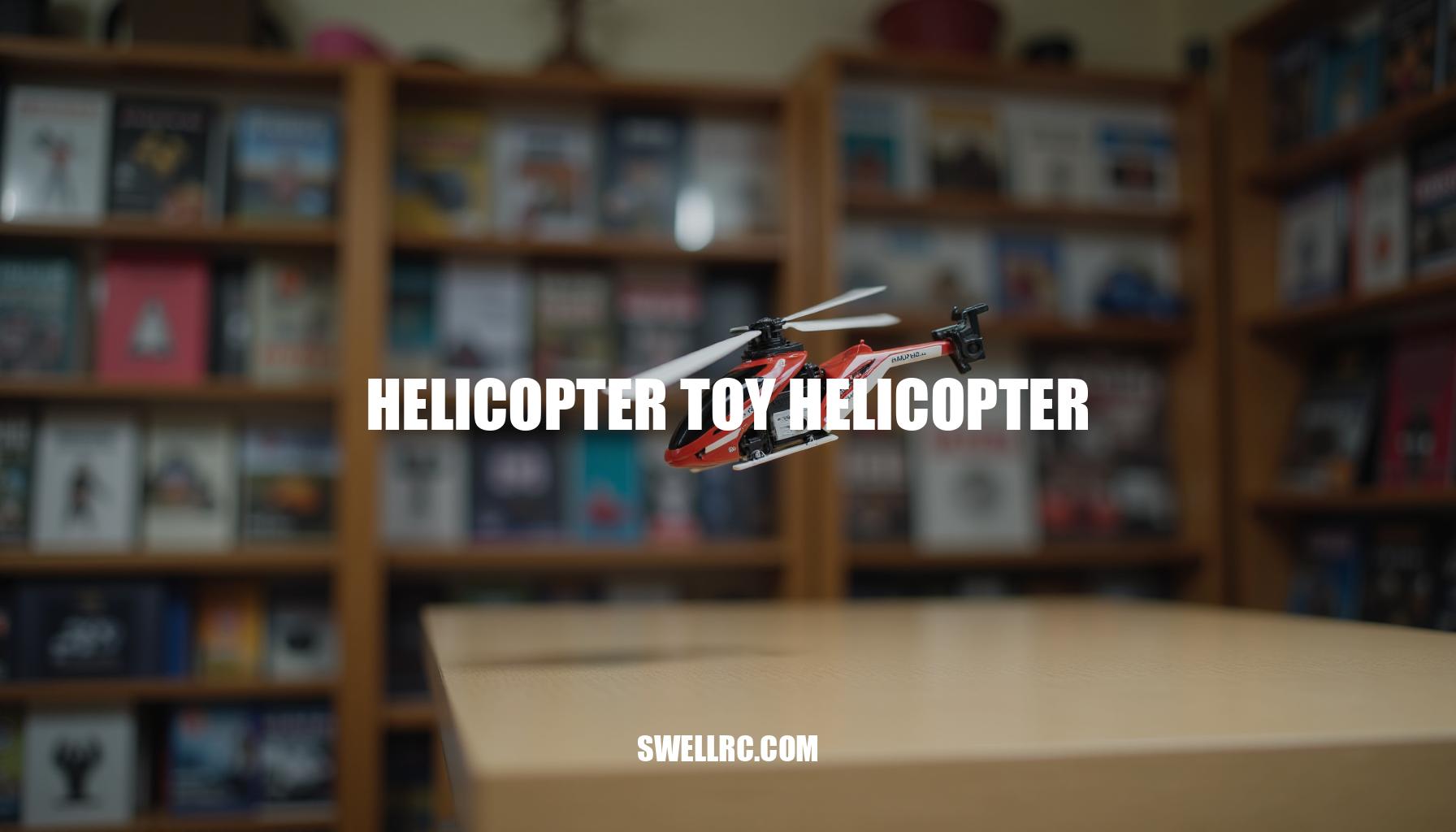The Ultimate Guide to Choosing the Best Helicopter Toy Helicopter for Beginners
I still remember the first evening I spun up a tiny RC helicopter in my living room and watched it hover like a hummingbird. I could not believe how advanced these small machines have become — from beginner-friendly coaxials to detailed scale models like the Exceed Remote Control Helicopter. After weeks of flying sessions, note-taking, and a few hilarious crashes, I learned what really separates a great remote control helicopter toy from a forgettable one: rock-solid stability, predictable controls, sensible battery life, and durable design.
Whether you’re choosing a flying toy as a drone alternative or exploring beginner helicopter models, these factors make all the difference. In this guide, I will share the discoveries that helped me fly better, buy smarter, and love the hobby more. Ready to decode miniature flight and find your perfect electric helicopter?
Let’s lift off.
Section One: How Toy Helicopters Work – The Magic Behind the Miniature Machines
Think of the main rotor like a powerful ceiling fan turned vertical: it pushes air down, generating lift upwards. This essential rotor blade design is the foundation of how helicopter toys fly. The tail rotor or a counter-torque system, such as a flybar or gyro system found on some models, counteracts the twist from the main rotor to prevent the body from spinning uncontrollably.
Key components that make these toys function include:
- Main rotor: creates the lift by pushing air downward.
- Tail rotor or counter-torque system: balances torque to keep stable yaw control.
- Brushed or brushless motors: power the rotors efficiently.
- Lightweight chassis: reduces weight for better flight dynamics.
- Swashplate (on single-rotor models): controls rotor blade pitch for maneuvering.
- Hand-held transmitter: sends your commands wirelessly at 2.4 GHz to the receiver onboard.
The tiny receiver mixes your throttle, yaw, pitch, and roll inputs, communicated through various channel configurations. For instance, 3.5 channel helicopters are common toys, providing basic altitude control and directional movement, whereas hobby-grade single-rotor models often use 4 channels, and advanced collective-pitch (CP) helicopters run up to 6 channels for precise maneuverability.
A crucial feature that helps keep these helicopters stable is gyro stabilization. Think of it as a self-correcting tightrope pole: if the helicopter drifts slightly, the gyro quietly nudges it back to center, smoothing out bumps and preventing small twitches from becoming wobbles.
Powering these lightweight marvels typically involves 1S lithium polymer batteries.
While higher milliamp-hour (mAh) ratings translate to longer flight times, they also add weight, demanding more from the rotor blades to maintain lift.
In my experience, the Double Horse 9101 hovered calmly in a hallway despite unsteady control inputs, showcasing the effectiveness of gyro stabilization and clever design. Similarly, the Hero RC H911 demonstrated that a well-tuned gyro and a light airframe can handle both indoor circuits and gentle outdoor breezes with ease.
Section Two: Types of Helicopter Toy Helicopters — Finding Your Match
There is a helicopter for every style and skill level, and understanding the difference between RC helicopter types is crucial for selecting the perfect model. Matching flight behavior to your goals is the fastest way to enjoy the hobby and progress confidently.
| Helicopter Type | Key Features | Ideal For |
|---|---|---|
| Coaxial Rotor | Two counter-rotating main rotors providing ultra-stable flight. | Beginners and indoor flying. |
| Single-Rotor | More agile than coaxials; fixed pitch design handles light outdoor air better. | Intermediate pilots seeking a next step from basics. |
| Collective Pitch (Stunt Helicopter) | Enables full aerobatics and 3D flight with a steep learning curve. | Experienced pilots looking for advanced stunt flying. |
| Micro and Nano Helicopter | Tiny, highly durable; perfect for living-room flying with short flight times. | Beginners wanting low-risk practice and casual flights. |
| Scale Helicopter | Detailed replicas modeled after real helicopters; slower, smooth, cinematic flight. Examples include the RC Bell 47. | Pilots interested in realism and stable laps. |
| Tandem/Double-Rotor | Two large main rotors in tandem providing unique stability and distinctive looks, such as the Boeing CH-47 Chinook RC Helicopter. | Enthusiasts seeking scale realism with stable flight characteristics. |
Personally, once I realized I loved smooth, cinematic laps more than stunt flying, my flying style transformed. I began choosing models that prioritize stability and scale realism, such as scale helicopters and tandem rotors, boosting my confidence and overall enjoyment of the hobby.
Section Three: Essential Features to Look For in a Helicopter Toy Helicopter
When it comes to navigating toy helicopter features, understanding what truly matters transforms shopping from a confusing task into an enjoyable experience. One key aspect is the gyro stabilization importance; models equipped with 3-axis or 6-axis gyros, along with auto-leveling and altitude hold functions, help convert shaky first flights into confident hovers. Another essential factor is the channel configuration: a 3 to 3.5 channel setup offers simplicity, 4-channel provides better directional control, and 6-channel collective pitch (CP) systems unlock advanced aerobatic capabilities.
Equally critical is the choice of lithium polymer battery—typically 1S LiPo packs ranging from 150 to 600 mAh deliver around 6–12 minutes of flight time and require 40–90 minutes of USB charging. Always prioritize safety by using the correct charger and never leaving batteries unattended. Build quality should not be overlooked; robust models feature flexible blades, reinforced skids, metal main shafts, or carbon supports to withstand crashes.
Easy access to spare parts further enhances value and longevity.
The rotor balance and mechanical integrity are crucial for performance and safety—regularly check rotor balance and tighten loose screws especially after impacts. Smooth transmitter feel with responsive gimbals, clear trims, and a reliable 2.4 GHz link ensures precise control. Two standout examples exemplify these qualities:
- Horizon Hobby AH-64 Apache – known for robust control and commanding presence.
- CH-53 Remote Control Helicopter – praised for design excellence and authentic scale vibes.
Pro tips to avoid rookie mistakes include avoiding battery overcharge by following charger indicators, ensuring tight screws and balanced rotors after any bump, flying in clutter-free areas to build muscle memory, and steering clear of windy conditions above 5–7 mph, as most toy helis perform best in calm environments.
Section Four: Testing the Skies – Real Flying Experience and Reviews
I flew an armful of helicopters across living rooms, garages, and calm parks to get a real-world RC helicopter review and see what really holds up in different environments. When considering indoor vs outdoor RC helicopter usage, micro coaxials proved perfect for tight indoor laps due to their agility and compact size, while single-rotor fixed pitch models performed better outdoors where there’s ample room to glide smoothly. Evaluating battery life and wind tolerance, I found that under 5 mph winds, many single-rotors handled the conditions well; however, above that threshold, lightweight toy frames tended to drift and drained batteries more quickly.
The balance between lightweight vs heavy-duty models is crucial: light helicopters react quickly and feel lively, but heavier builds track straighter and endure bumps better. For instance, the Air Combat RC Helicopter VAT19 (link) felt notably planted compared to ultra-light micros. For those looking for beginner helicopter models, the Smyths Toys RC Helicopter (link) offers an accessible first purchase to learn the ropes without a steep investment or worry of breaking the bank.
Here’s a quick summary of what I learned after dozens of batteries and countless flights:
- Stability and clean throttle response matter more than raw speed for controlled, enjoyable flights.
- Predictable hover performance builds confidence — fancy features are useless if the basics are shaky.
- Spare parts availability saves both money and momentum, so always check parts support before buying.
Section Five: Where Enthusiasts Gather – Helpful RC Helicopter Resources
The fastest way to level up in flying RC helicopters is to learn alongside experienced pilots who fly more often than you do. Engaging with RC helicopter resources such as forums and communities can significantly boost your skills. Look for active RC forums where pilots share valuable setup tips, crash fixes, and detailed tuning guides.
Additionally, watching YouTube reviewers is a great strategy; they often provide flight demos, durability tests, and thorough setup walkthroughs that are helpful before making a purchase. Curated RC databases like the RC Helicopter Websites serve as excellent launchpads for discovering niche communities and expert hubs.
To get the most from these communities and resources, consider the following:
- Post clear questions accompanied by photos or short clips to showcase issues you need help troubleshooting.
- Start a flight log and share your settings that worked well, helping others and building your credibility.
- Learn the basics of LiPo battery care and safety early on to avoid common pitfalls and enhance your overall flying experience.
By combining insights from troubleshooting tips shared in forums, guidance from YouTube reviewers, and comprehensive data from RC databases, you’ll accelerate your progress and enjoy flying your RC helicopter to its fullest potential.
Conclusion: My Takeaways After Countless Flights
From that first wobbly hover to smooth, room-wide orbits, exploring the best RC helicopters for beginners has been a journey of pure discovery. The best helicopter toy combines precision control, durable design, and a body tough enough to survive the occasional pilot error. Whether you choose an electric helicopter or another type, with a little practice and the right match for your skills, you will find a rhythm that offers immersive enjoyment akin to a meditative flow.
When searching for the ideal model, consider these key factors:
- Precision Control: Essential for mastering flight and making smooth maneuvers.
- Durable Design: Helps withstand inevitable crashes and pilot mistakes.
- Ease of Use: Especially important for beginners to foster confidence and skill development.
- Flight Time: Longer battery life means more time enjoying the air.
Keep exploring models, keep asking questions, and keep flying with curiosity — the technology behind the best RC helicopters for beginners keeps evolving, and the joy of mastering miniature flight never gets old.
Frequently Asked Questions
- How do helicopter toys actually fly?
Their spinning main rotor pushes air downward to create lift while a tail rotor or electronic stabilization counters torque. A 2.4 GHz radio link sends your throttle and direction inputs to onboard electronics that mix motor power to climb, turn, and move. - What is the difference between a drone and a toy helicopter?
Drones (multirotors) use several propellers and advanced stabilization to hover very easily. Toy helicopters use one main rotor (often with a tail rotor) and feel more like traditional aircraft; they can be more challenging but offer a classic, rewarding flight experience. - Are toy helicopters safe for kids?
Yes with supervision. Choose beginner-friendly models, fly in open spaces, keep hair and fingers away from spinning blades, and follow LiPo charging safety. Check the manufacturer’s age rating and wear eye protection for close indoor flying. - Which helicopter toy is best for beginners?
A coaxial or stable 3 to 3.5-channel model is ideal for easy hovering and gentle control. As skills grow, move to a 4-channel single-rotor fixed-pitch helicopter for better outdoor handling. - How long does a typical charge last on an RC helicopter?
Most toy RC helicopters fly 6–12 minutes per charge and need about 40–90 minutes to recharge, depending on battery capacity and charger type. - Can I fly my helicopter toy outdoors?
Yes in light winds and open areas. Small coaxials are best indoors; single-rotor fixed-pitch models handle breezes better. Avoid gusty conditions, trees, and crowds, and always keep the model in line of sight. - What’s the best type of remote control helicopter for adults?
Adult beginners often enjoy 4-channel single-rotor fixed-pitch models for a good balance of challenge and control. Experienced pilots seeking aerobatics should consider 6-channel collective-pitch helicopters. - How important is gyro stabilization in helicopter toys?
Very important. A good gyro reduces wobble, helps maintain hover, and makes control inputs feel precise. It is the difference between fighting the model and focusing on smooth, confident flight.



